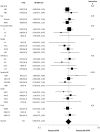Intracranial Bleeding After Reperfusion Therapy in Acute Ischaemic Stroke Patients Randomized to Glyceryl Trinitrate vs. Control: An Individual Patient Data Meta-Analysis
- PMID: 33193044
- PMCID: PMC7606455
- DOI: 10.3389/fneur.2020.584038
Intracranial Bleeding After Reperfusion Therapy in Acute Ischaemic Stroke Patients Randomized to Glyceryl Trinitrate vs. Control: An Individual Patient Data Meta-Analysis
Erratum in
-
Corrigendum: Intracranial Bleeding After Reperfusion Therapy in Acute Ischaemic Stroke Patients Randomized to Glyceryl Trinitrate vs. Control: An Individual Patient Data Meta-Analysis.Front Neurol. 2020 Nov 26;11:625572. doi: 10.3389/fneur.2020.625572. eCollection 2020. Front Neurol. 2020. PMID: 33324341 Free PMC article.
Abstract
Background: Thrombolysis, with or without thrombectomy, for acute ischaemic stroke is associated with an increased risk of intracranial bleeding. We assessed whether treatment with glyceryl trinitrate (GTN), a nitric oxide donor, may influence the associated bleeding risk. Methods: We searched for completed randomized controlled trials of GTN vs. no GTN in acute ischaemic stroke with data on reperfusion treatments (thrombolysis and/or thrombectomy). The primary efficacy outcome was functional status as assessed by the modified Rankin Scale (mRS) at day 90; the primary safety outcome was intracranial bleeding. Secondary safety outcomes included symptomatic intracranial hemorrhage and haemorrhagic transformation of infarction. Individual patient data were pooled and meta-analysis performed using ordinal or binary logistic regression with adjustment for trial and prognostic variables both overall and in those randomized within 6 h of symptom onset. Results: Three trials met the eligibility criteria. Of 715 patients with ischaemic stroke who underwent thrombolysis (709, >99%) or thrombectomy (24, 3.4%), 357 (49.9%) received GTN and 358 (50.1%) received no GTN. Overall, there was no difference in the distribution of the mRS at day 90 between GTN vs. no GTN (OR 0.94, 95% CI 0.72-1.23; p = 0.65); similarly, there was no difference in intracranial hemorrhage rates between treatment groups (OR 0.90, 95% CI 0.43-1.89; p = 0.77). In those randomized to GTN vs. no GTN within 6 h of symptom onset, there were numerically fewer bleeding events, but these analyses did not reach statistical significance. Conclusions: In ischaemic stroke patients treated predominantly with thrombolysis, transdermal GTN was safe, but did not influence functional outcome at 90 days.
Keywords: bleeding; glyceryl trinitrate; ischaemic stroke; meta-analysis; reperfusion; thrombectomy; thrombolysis.
Copyright © 2020 Appleton, Woodhouse, Sprigg and Bath.
Figures



Similar articles
-
Prehospital transdermal glyceryl trinitrate in patients with ultra-acute presumed stroke (RIGHT-2): an ambulance-based, randomised, sham-controlled, blinded, phase 3 trial.Lancet. 2019 Mar 9;393(10175):1009-1020. doi: 10.1016/S0140-6736(19)30194-1. Epub 2019 Feb 6. Lancet. 2019. PMID: 30738649 Free PMC article. Clinical Trial.
-
Rapid Intravenous Glyceryl Trinitrate in Ischemic Damage (RIGID): A potential neuroprotection strategy for acute ischemic stroke (AIS) patients.Neurotherapeutics. 2024 Jul;21(4):e00365. doi: 10.1016/j.neurot.2024.e00365. Epub 2024 Apr 23. Neurotherapeutics. 2024. PMID: 38658264 Free PMC article. Clinical Trial.
-
Multicentre Randomised trial of Acute Stroke treatment in the Ambulance with a nitroglycerin Patch (MR ASAP): study protocol for a randomised controlled trial.Trials. 2019 Jun 26;20(1):383. doi: 10.1186/s13063-019-3419-z. Trials. 2019. PMID: 31242931 Free PMC article.
-
Intravenous thrombolysis and endovascular thrombectomy for acute ischaemic stroke in patients with Moyamoya disease - a systematic review and meta-summary of case reports.J Thromb Thrombolysis. 2022 Aug;54(2):339-349. doi: 10.1007/s11239-022-02670-0. Epub 2022 Jun 14. J Thromb Thrombolysis. 2022. PMID: 35699873
-
Direct mechanical thrombectomy without intravenous thrombolysis versus bridging therapy for acute ischemic stroke: A meta-analysis of randomized controlled trials.Int J Stroke. 2021 Aug;16(6):621-631. doi: 10.1177/17474930211021353. Epub 2021 Jun 2. Int J Stroke. 2021. PMID: 34003709
Cited by
-
Association between malnutrition risk and hemorrhagic transformation in patients with acute ischemic stroke.Front Nutr. 2022 Oct 5;9:993407. doi: 10.3389/fnut.2022.993407. eCollection 2022. Front Nutr. 2022. PMID: 36276820 Free PMC article.
-
Nitrate Metabolism and Ischemic Cerebrovascular Disease: A Narrative Review.Front Neurol. 2022 Mar 3;13:735181. doi: 10.3389/fneur.2022.735181. eCollection 2022. Front Neurol. 2022. PMID: 35309590 Free PMC article. Review.
References
-
- Emberson J, Lees K, Lyden P, Blackwell L, Albers G, Bluhmki E, et al. . Effect of treatment delay, age and stroke severity on the effects of intravenous thrombolysis with alteplase for acute ischaemic stroke: a meta-analysis of individual patient data from randomised trials. Lancet. (2014) 384:1929–35. 10.1016/S0140-6736(14)60584-5 - DOI - PMC - PubMed
-
- Anderson CS, Huang Y, Lindley RI, Chen X, Arima H, Chen G, et al. . Intensive blood pressure reduction with intravenous thrombolysis therapy for acute ischaemic stroke (ENCHANTED): an international, randomised, open-label, blinded-endpoint, phase 3 trial. Lancet. (2019) 393:877–88. 10.1016/S0140-6736(19)30038-8 - DOI - PubMed
Publication types
Grants and funding
LinkOut - more resources
Full Text Sources
Miscellaneous

